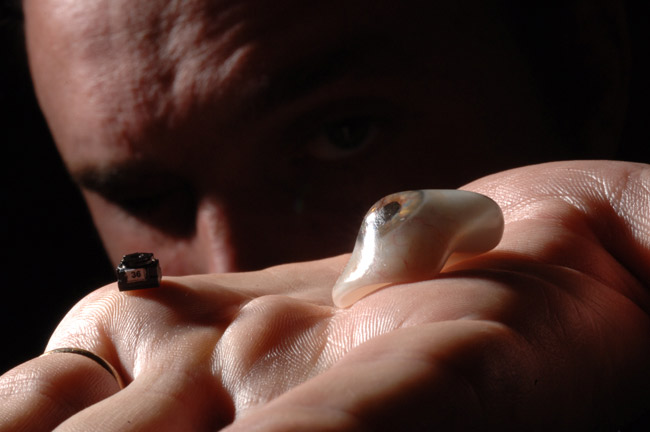Robot Madness: Human Becomes 'EyeBorg'

In Robot Madness, LiveScience examines humanoid robots and cybernetic enhancement of humans, as well as the exciting and sometimes frightening convergence of it all. Return for a new episode each Monday, Wednesday and Friday through April 6.
Clunky artificial vision systems have begun restoring limited vision to blind people. But a one-eyed filmmaker wants to look at cyborg enhancement differently by wearing a bionic eye camera.
Robert Spence plans to create a documentary on his experience of trying to become "EyeBorg." Under development, his bionic eye is relatively thin and would sit on a peg embedded in his right eyeball, meaning that it could move left, right, up and down. Rather than restoring vision to his busted eye, "EyeBorg" represents an effort to shrink wearable technologies and embed them, unnoticed, as part of the human body.
However, don't expect lengthy, first-person views similar to those in movies such as "Being John Malkovich" or "The Diving Bell and the Butterfly." Spence said that clips of the view from his eye camera would be used sparingly in the documentary.
"Even right now, it's probably too much to try to watch someone to ask a whole film of that," Spence said. "It would just make them sick."
The filmmaker damaged his right eye as a 13-year-old while playing with his grandfather's gun, and eventually had surgery to wear a non-functional prosthetic eye. However, he began having sci-fi visions inspired by shows such as "The Bionic Man."
{{ video="LS_090309_02_EyeCyte.flv" title="Robotic Eye-Cyte May Bring Vision to Blind People" caption="Neural messages sent by cyber-circuits may supply artificial vision. Such cyber-sight devices will likely shrink to cellular-size. Credit: Thomas Lucas, Producer / Rob Goldberg, Writer" }}
Sign up for the Live Science daily newsletter now
Get the world’s most fascinating discoveries delivered straight to your inbox.
His current bionic eye design contains a wireless video camera sandwiched between two layers of a prosthetic eye. That was the brainchild of Kosta Grammatis, a former engineer for the rocket firm SpaceX, who has crashed in Spence's "spare bedroom lab" for the past few weeks.
Grammatis scrounged his components for the tiny video camera system from anywhere and everywhere. The wireless transmitter is the same as those used in small unmanned aerial vehicles deployed by the U.S. military, while the camera came from the tip of a colonoscopy instrument. Batteries came from Bluetooth headsets.
"Now it's a matter of wiring it together and we'll have a working prototype," Grammatis told LiveScience, adding that the tiny camera was successfully transmitting images up to four feet away. Spence would wear a transmitter elsewhere on his body to boost the signal and send it to a hard drive, and eventually upload the information in real time to the Internet. People from all over the world might then see from Spence's perspective.
The project may not represent a huge technological innovation, but it does address the engineering challenge of squeezing a camera system into a tiny space. Current artificial vision systems designed by researchers at Johns Hopkins and other universities require people to have eye implants and wear bulkier cameras on eyeglasses.
Still, researchers are creating even smaller, high-performance "eye" cameras. A team from the University of Illinois and Northwestern University announced the creation of a tiny camera based on an array of silicon detectors and electronics embedded in stretchable, interconnected mesh. That work was detailed in the August 2008 issue of Nature.
Spence's effort currently runs on a shoestring budget backed by techies volunteering their time and expertise. Companies such as OmniVision have donated some product samples, but no one has stepped forward to offer funding yet.
Grammatis spoke wistfully of joining forces with artificial vision researchers to tackle the issue from both sides, and perhaps taking another step closer to robot-human convergence.
"If someone became interested and gave us research dollars, I would love to work with [them] and create a full-blown, drop-in bionic eye solution," Grammatis said.
Robot Madness Episode 4: Emotional Disasters
- Video - Robotic "Eye-Cyte" May Bring Vision to Blind People
- Robot Madness Episode 2: Creating True Artificial Intelligence
- More Robot News and Information










